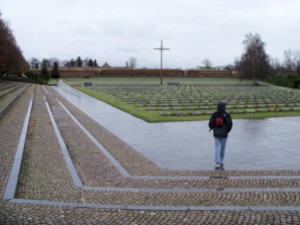The other portion of town is called the Small Fortress, which was historically a jail for political prisoners. In 1940, the jail was taken over by the SS and was operated by Nazis for the remainder of the war. To get to the gates of the Small Fortress, you have to exit the main part of the complex, cross a bridge over the rushing river Ohre, and walk through vast Jewish and Christian cemeteries with unmarked gravestones. During World War II, the cemetery quickly filled up, and most of the 32, 500 prisoners who died in Terezin were not given a proper burial, but were sent to the crematorium at the far edge of the Big Fortress. On certain days, the crematorium can be viewed by the public, though it was closed when I visited.
As I walked to the Small Fortress, cold rain began to fall and the streets were deserted. The utter desolation of the place chilled me, and its impact on me is perhaps best represented by a photograph that I took during the walk to the Small Fortress. A lone figure walks through the rain, crosses the wet stone pathway that cuts through the cemetery, with rows of graves stretching out endlessly. A plain cross can be seen far ahead, as can black trees whose bare branches seem to claw at the gray sky. And in the distance is a grayish stone wall, the barrier which once enclosed people inside the Small Fortress of Terezin.

Is there a functioning town, like stores and schools and all? I agree that it must be very strange to live in a place with such painful history.
I’d love to see your photo closer up, to really see those trees and to be able to make out the details of the wall.
Thanks for the blog.
Thank you for your comment and for your interest in the blog. Today the town has a population of about 3,000 today, and does have some stores, a hotel, a few small restaurants and parks and a post office. Apparently it also is known for its production of furniture and knitwear and was used as a military base until the mid 1990s.
I will definitely send you a larger version of the picture.